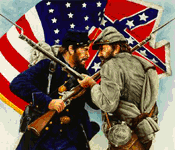 |
Civil War Battles |
|
State War Records |
| AL - AK - AZ - AR - CA - CO - CT - DE - FL - GA - HI - ID - IL - IN - IA - KS - KY - LA - MA - MD - ME - MI - MN - MS - MO - MT - NE - NV - NH - NJ - NM - NY - NC - ND - OH - OK - OR - PA - RI - SC - SD - TN - TX - UT - VT - VA - WA - WV - WI - WY |
The Battle of Johnsonville
November 4-5, 1864 in Benton County and Humphreys County, near Johnsonville, Tennessee
 |
|||||||||||||||||||
|
Soon after the fall of Atlanta on September 2, 1864, Confederate Lieutenant General John Bell Hood began a westward flanking movement originally intended to cut the supply lines of Union General William T. Sherman and draw him north to Tennessee in pursuit of Hood's army. In mid-October, a month before Hood's invasion, Major General Nathan Bedford Forrest had moved north from Corinth, Mississippi, to menace Federal defenses.
He reached the west bank of the Tennessee River at the Kentucky line on October 28 with some 3,500 cavalry and infantry. Capturing a gunboat and a transport as a diversion, Forrest secretly positioned his ten cannons across the river from Johnsonville, named in honor of Military Governor Andrew Johnson, the western terminus of the Nashville and Northwestern Railroad. The heavily fortified supply depot was built and manned in part by regiments of the U.S. Colored Troops.
On the afternoon of November 4, Forrest's gunners opened fire on three gunboats, eleven transports, and eighteen barges. Union forces numbered about 2,000 men under the command of Lieutenant E. M. King and Colonel C. R. Thompson. Assuming Forrest was ready to cross the river with more than 13,000 troops, the Union commanders burned the vessels to prevent their capture. The fire spread to the docks and warehouses, and Federal batteries positioned above the depot could not eliminate the well-entrenched guns across the river.
In the confusion, the stationmaster headed east with a train loaded with supplies and 400 men, some of whom looted the stores. The boxcars were abandoned at Waverly, and the tender and engine continued on to Nashville, seventy-eight miles to the east.
The blazing docks and warehouses illuminated the river sufficiently to enable Forrest to evacuate his position during the night and move his forces six miles south. An artillery detachment left behind as a rear guard continued shelling the town the next morning. By the time reinforcements arrived from Nashville, Forrest's artillery had been removed. Forrest arrived in Corinth on November 10 with 150 prisoners and reported to Hood in Florence, Alabama, on November 14.
The Confederates reported two dead, nine wounded, and the capture of 150 prisoners. Union losses were eight killed and wounded. Forrest estimated the value of the vessels and equipment he destroyed to be $6.7 million, although Union estimates were considerably lower.
Forrest's movements caused a panic, and one report had him near Chicago with 14,000 men. Major General Joseph Hooker took the report seriously enough to move troops from Indianapolis and St. Louis to defend the city. Ultimately, though, the Johnsonville raid failed to impede the well-supplied Sherman on his march to the sea; nor did it prevent the destruction of Hood's forces at Franklin and Nashville.
